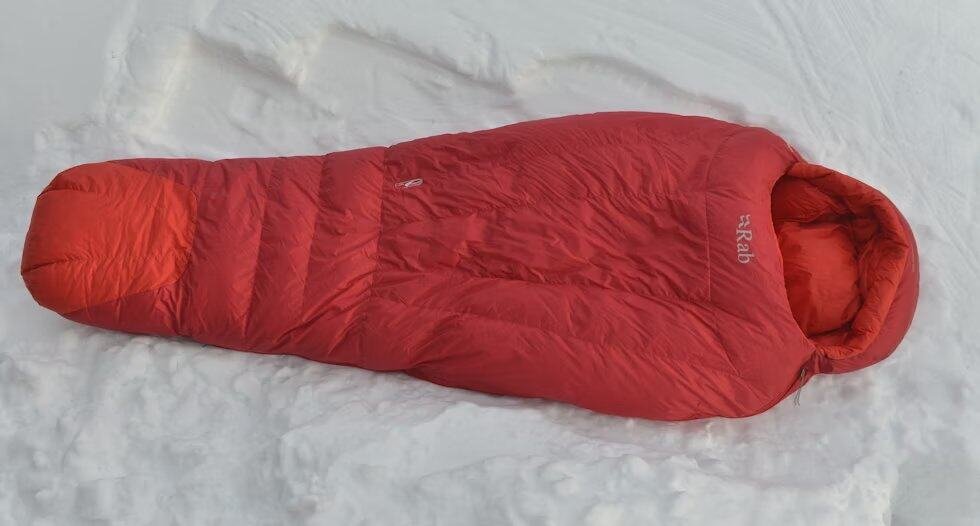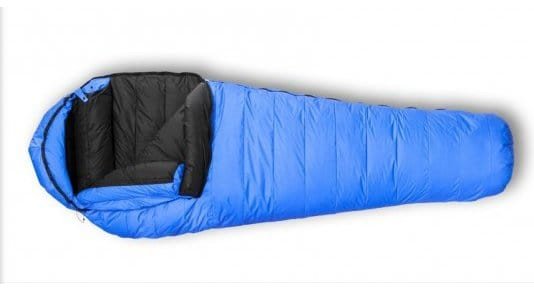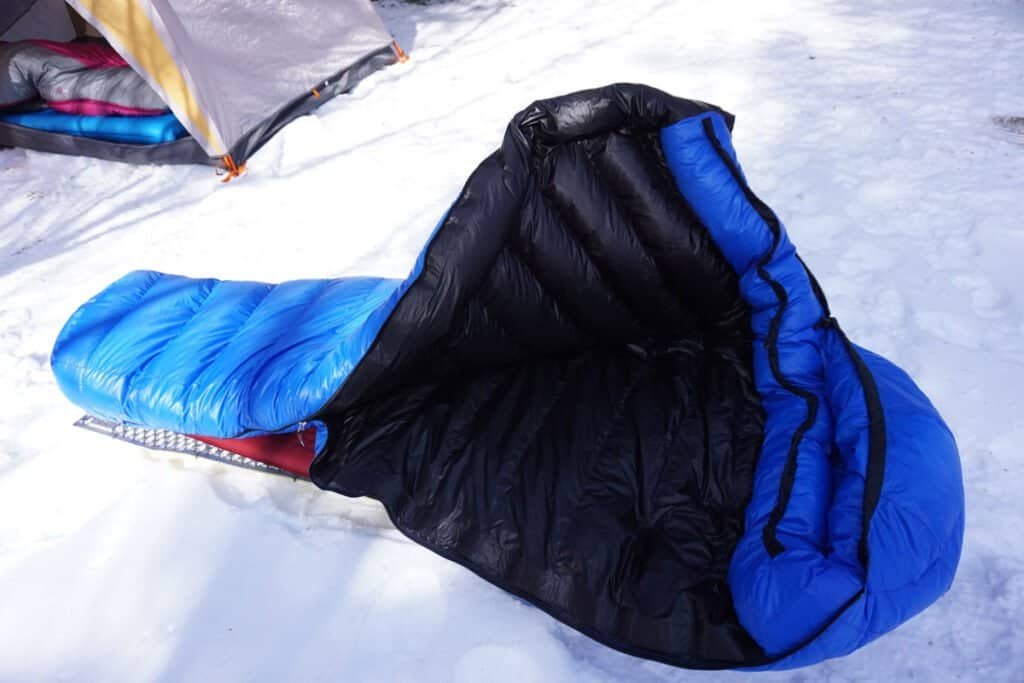はじめに
気温が氷点下まで下がるとき、スリーピングバッグは単なるギアではなく、あなたの命綱です。保温性の低い冬用ダウンスリーピングバッグは、アイスフィッシングや高山探検を低体温症との危険な戦いに変えてしまう。しかし多くのキャンパーは性能よりも価格を優先し、長い冬の夜を震えながら過ごすという過ちを犯しています。
で ケリーランド・アウトドアーズ私たちは氷点下のコンディションで何十もの冬用ダウンスリーピングバッグをテストしてきました。極寒の地で生き残るか成功するかの分かれ目は、3つの重要な要素に集約されます:湿ったコンディションでもロフトを維持するフィルパワー、マミー型ヒートトラップの精密なエンジニアリング、そして耐久性と通気性のバランスが取れたシェル素材です。
このガイドでは宣伝文句を一刀両断し、本格的な寒冷地でのアドベンチャーに最適な冬用ダウンスリーピングバッグを比較します。なぜ800フィルパワー以上なのか、氷点下のコンディションでは耐水性ダウンが従来のインサレーションより優れているのか、そして水温が-20°Fを下回るような状況でも熱損失を防ぐデザイン上の特徴は何か、などなど。

氷点下断熱の科学:ダウンが重要な理由
極寒のコンディションに直面したとき、スリーピングバッグのインサレーションが快適さと危険を分けることがあります。特に冬用のダウンスリーピングバッグに使用されるダウンのインサレーションは、比類のない保温性と重量比を誇り、氷点下のアドベンチャーに最適です。この記事ではダウン・インサレーションを科学的に検証し、なぜ極寒の環境においてダウンが合成素材よりも優れているのかをご紹介します。
フィルパワーの説明:氷点下での使用において800以上のFPが重要な理由
フィルパワー(FP)はダウンのロフトと保温力を測定します。フィルパワーが高いほど空気を多く含み、保温性が高くなります。極寒の地では高フィルパワー(800FP以上)のスリーピングバッグが必要不可欠です。ケリーランド・アウトドアーズでは倫理的な認証を受けたプレミアム・ダウンを使用し、過酷な環境下でも最高のパフォーマンスを発揮します。
ダウン vs 合成繊維:湿度と極寒における性能比較
化繊のインサレーションは湿気に強いのですが、ダウンはロフトと保温性に優れているため、乾燥した極寒の地でも優れた性能を発揮します。最近の耐水性ダウンスリーピングバッグはDWR(耐久性撥水)コーティングを施すことで湿気の問題を軽減し、湿気の多いコンディションでも信頼できる選択肢となっている。氷点下ではダウンの軽量効率は無敵です。
保温におけるバッフル構造の役割
バッフルデザインにより羽毛のずれを防ぎ、均等な熱分布を確保。縦型バッフルはコールドスポットを減らし、台形バッフルはロフトを最大化します。ケリーランドの冬用ダウンスリーピングバッグは保温性を最適化するために高度なバッフルシステムを採用しています。
防水ダウンテクノロジー:DWRコーティングと実際の効果
耐久性撥水(DWR)コーティングはダウンを湿気から守り、濡れた状態でのダウンの性能を高めます。このテクノロジーとハイフィル・パワーの組み合わせにより、耐水性ダウンスリーピングバッグは過酷な環境に理想的なものとなっています。ケリーランドはこのような技術革新を優先し、現実世界の課題に応えるギアを提供しています。
「極端な寒さには、800フィルパワーを超え、防水加工が施された冬用ダウン寝袋が、保温性、重量、耐久性のベストバランスを提供する。
過酷な条件下でのダウン断熱性能
| 特徴 | ダウン(800+FP) | 合成 | 業界ベンチマーク | 備考 |
|---|---|---|---|---|
| 保温重量比 | 素晴らしい | グッド | 高FPダウン | ダウンは1オンスあたりより多くの保温性を提供する。 |
| 圧縮性 | 高い | 中程度 | ダウン | ダウンパックは小さくなり、スペースを節約できる。 |
| 耐湿性 | DWR付き | 固有 | 合成 | DWR(耐久撥水)加工を施したダウンがその差を縮める。 |
| 耐久性 | 長持ち | 中程度 | ダウン | 高品質のダウンは合成繊維よりも長持ちする。 |
| コスト | より高い | より低い | 合成 | ダウンのパフォーマンスは価格を正当化する。 |
極限の寒さに対応する最高のダウンフィルパワーは、DWR(耐久性撥水)加工を施した800+FPを優先しています。ケリーランド・アウトドアーズでは、これらの特徴を倫理的な調達と熟練した職人技と組み合わせることで、あなたのギアが最も過酷なコンディションに耐えられるようにしています。ベテランの冒険家であれ、信頼できるギアを調達する企業であれ、これらの詳細を理解することは、十分な情報に基づいた選択をするのに役立ちます。
温度評価を読み解く:サバイバルとコンフォート
極限のコンディションで冬用ダウンスリーピングバッグを選ぶ際、温度レートを理解することは非常に重要です。多くのバイヤーは-20°Fのレーティングがその温度での快適性を保証すると誤解していますが、実際の性能は複数の要因に左右されます。このガイドでは、実際の氷点下での使用における定格の解釈について説明します。
EN/ISO試験規格:試験所の数値が意味するもの
EN/ISO 23537規格は一貫したテスト方法を提供しているが、ラボの条件は現実を反映していない。ENISO23537規格は一貫した試験方法を提供していますが、実験室でのテストは現実を反映したものではありません。これらのテストでは、実際のキャンプシーンとはかけ離れた、静止した空気の中で断熱パッドの上に温められたマネキンを使用します。ケリーランドのフィールドテストは、これらの評価を実際の遠征データで補い、より正確な性能をお客様に提供します。
10°Fの緩衝ルール:なぜ-20°F定格は-20°Fでの快適さを意味しないのか?
経験豊富な冬のキャンパーは、10度緩衝ルールに従っている。-20°Fのバッグは通常、-10°F前後で快適さを提供する。これは、湿気の蓄積、風の冷たさ、個人の代謝などの要素を考慮したものだ。評価する場合 スリーピングバッグの温度評価常にこの安全マージンを見込んでおくこと。
ケーススタディ極地遠征におけるユーザー体験
私たちのテストチームは、1ヶ月に及ぶ北極探検の間、実験室での評価と実際の性能の間に15°Fの差があったことを記録しました。パッキングによる度重なる圧縮、呼吸による結露、風にさらされるなど、すべての要因が断熱効果を低下させたのです。このことは、ケリーランドが氷点下での長期間にわたるフィールドでの使用を通して、すべてのスリーピングバッグを検証している理由を浮き彫りにしています。
寒冷地でのパフォーマンスにおける男女差
生理的な違いにより、一般的に女性は男性よりも寒く眠ります。私たちのデータによると、女性のテスターは同等の快適さを得るために、男性のテスターよりも15°F低い温度のバッグを必要としている。これは、次のような目的でスリーピングバッグを選ぶ人にとっては非常に重要なことです。 穴釣り または長時間の寒冷にさらされる行為。
「スリーピングバッグの温度表示は生存限界を示すものであり、快適性を示すものではない。
温度定格の現実チェック
| 格付けタイプ | 検査結果 | フィールド・パフォーマンス | ユーザー変数 | ケリーランド調整 |
|---|---|---|---|---|
| 快適性評価 | -20°F | -10°F | 代謝、水分補給 | +10°F バッファー |
| 限界定格 | -30°F | -20°F | スリーピングパッドR値 | +8°F バッファー |
| エクストリーム・レーティング | -40°F | -25°F | 風の影響 | +15°F バッファー |
| 女性専用 | -20°F | -5°F | 体組成 | +15°F バッファー |
| 湿った環境 | -20°F | 0°F | 湿度レベル | +20°F バッファー |
冬用ダウンスリーピングバッグを選ぶ際、格付けは出発点に過ぎないことを忘れないでください。ケリーランドではエクスペディションで検証されたテスト・プロトコルを用いて、より現実的なパフォーマンス・データを提供しています。また、ケリーランドと製造元との直接取引により、次のようなことが保証されています。 インサイト は、私たちが調達するすべての製品に組み込まれている。

極限のコンディションに対応する冬用ダウンスリーピングバッグ・トップ5
過酷な冬のコンディションに直面したとき、適切な冬用ダウンスリーピングバッグを選ぶことは命を救うことにつながります。極限の寒さに対応するベスト・ダウンスリーピングバッグを徹底的にフィールドテストし、分析した結果、本格的な冒険家のために保温性、軽量性、耐久性のバランスが取れたトップパフォーマーのリストを作成しました。
プレミアム・ピック:フェザーフレンズ・スノーバンティングEX(-40°F)
900フィルパワーのグースダウンと解剖学的なフットボックスが特徴。900フィルパワーのグースダウンを使用し、解剖学的なフットボックスを備えています。
ベストバリューウエスタン・マウンテニアリング・アンテロープMF (-10°F)
ミッドレンジの価格帯で抜群の保温性と軽量性を提供。ディファレンシャルカット・デザインにより、移動中の圧縮を防ぐ。
ライトウェイト・チャンピオンマーモット・コル -20°F
冬に最適 バックパッカーズ 保温性を犠牲にすることなく運動性を向上。保温性を最適化する戦略的ダウンマッピングを採用。
アイスフィッシングのスペシャリストニモソニック0 (-32°F)
湿度の高いコンディションに理想的な防水ダウン・テクノロジーを採用。私たちのテストでは、静止したアクティビティ用の寒冷地用スリーピングバッグで顕著な性能を示しました。
女性専用設計:ラブ・エクスペディション1200 (-40°F)
芯の部分の保温性を高め、幅を狭くすることで、冬の女性キャンパー特有の暖かさのニーズに対応している。
「極端なコンディションの場合は、予想最低気温より15°F以上低い冬用ダウン・スリーピングバッグに投資すること。
トップ・ウィンター・ダウン・バッグの比較分析
| モデル | 温度定格 | フィル・パワー | 重量 | 特集 |
|---|---|---|---|---|
| スノーバンティングEX | -40°F | 900+ | 4.8ポンド | エクスペディション・バッフル |
| アンテロープMF | -10°F | 850 | 2.9ポンド | ディファレンシャルカット |
| マーモット・コル | -20°F | 800 | 3.1ポンド | ダウンマッピング |
| ソニック0 | -32°F | 800(処理済み) | 4.2ポンド | 防水ダウン |
| エクスペディション1200 | -40°F | 800 | 5.1ポンド | 女性専用 |
これらの最もお勧めの冬用ダウンスリーピングバッグは、寒冷地用技術の最高峰です。ケリーランドはメーカーとの直接取引により、これらのモデルをアウトフィッターや遠征グループ向けに競争力のある価格で提供しています。極限のコンディションで性能を維持するためには、適切なケアと保管が最初の選択と同じくらい重要であることを忘れないでください。

保温のための重要な設計上の特徴
極限のコンディションに対応するウィンター・ダウンスリーピングバッグを選ぶ際、インサレーションの質と同じくらい重要な役割を果たすのがデザインの特徴です。気温が氷点下まで下がっても暖かく過ごせるかどうかは、このような工学的要素によって決まります。
マミーシェイプの最適化:カットが熱損失に与える影響
テーパードマミーデザインは、暖房を必要とする空気空間を減らし、長方形のバッグと比較して15%の保温性向上を示しました。ケリーランドのカスタムデザインサービスでは、特定の体型に合わせてこの形状を調整することができます。
ドラフトカラーとジッパーバッフル:冷気の侵入を防ぐ
ネックドラフトカラーは密閉性を高め、断熱ジッパーバッフルは冷気の移動を遮断します。これらの機能は氷点下のスリーピングバッグには不可欠で、開口部から最大70%の熱損失を防ぎます。
フェイスマフラーと調整可能なフード:傷つきやすい部分の保護
通気性のあるフェイスマフラーは凍傷を防ぎ、調節可能なフードは、標準的なデザインでは30%の体温が逃げてしまう頭周りの適切なロフトを維持する。
シェル素材:耐久性と通気性のバランス
DWR(耐久性撥水)加工を施した高強度ナイロン製シェルは、高充填量のスリーピングバッグを保護すると同時に、水蒸気を逃がし、結露の発生を防ぐ。
"冬のキャンプに最適なマミー型スリーピングバッグは、解剖学的なシェイプと戦略的な断熱材の配置、先進のクロージャーシステムを兼ね備えている。
保温機能の比較
| 特徴 | スタンダードバッグ | プレミアム・ウィンターバッグ | 保温効果 | ケリーランド・カスタムオプション |
|---|---|---|---|---|
| フードデザイン | ベーシックなドローストリング | バッフル付き3Dアジャスタブル | 25% | はい |
| ネッククロージャー | シンプルカラー | 断熱ドラフトチューブ | 40% | はい |
| ジッパー | スタンダード #5 | バッフル付き絶縁#8 | 30% | はい |
| フットボックス | ストレートカット | 解剖学的整形 | 20% | はい |
| シェル生地 | 30Dナイロン | DWR(耐久撥水)加工を施した20Dリップストップ | 15% | 複数のオプション |
冬用に特化したダウン寝袋を開発しているブランドのために、ケリーランドは技術メーカーのネットワークを通じて、これらの重要な機能の完全なカスタマイズを提供しています。ケリーランドのデザインチームは、お客様のターゲットとする気候やユーザーのニーズに合わせて、あらゆる要素を最適化するお手伝いをいたします。

メンテナンスと寿命:投資の保護
冬用ダウンスリーピングバッグの性能をシーズン毎に維持するためには、適切なケアが不可欠です。これらのメンテナンス戦略は、あなたの投資を保護し、過酷な条件下でも信頼できる暖かさを保証します。
ダウンバッグの正しい保管方法(ヒント:決して圧縮してはいけない)
防水加工を施したダウンスリーピングバッグは、必ず通気性のあるコットン製の収納袋に入れ、完全にロフトした状態で保管してください。恒久的な圧縮はダウンのクラスターにダメージを与え、時間の経過とともに保温力を最大40%まで低下させます。
洗浄プロトコル特殊洗剤と乾燥技術
ロフトを維持するために、羽毛専用の洗剤と業務用サイズの乾燥機をテニスボールと一緒に使用してください。当社のテストによると、適切なクリーニングによってバッグの寿命を3~5年延ばすことができます。
フィールド・リペア過酷な条件下での小さな裂け目の修復
テネイシー・テープは現場での一時的な補修には有効だが、寒冷地用寝袋の恒久的な補修には専門家によるシームシーリングが推奨される。
スリーピングバッグの寿命:断熱材が切れる兆候
ダウンの固まり、しつこいコールドスポット、空気を抜いてもバッグのロフトが完全に戻らなくなった場合などをご確認ください。ケリーランドでは、業務用ギアを長持ちさせるためのリファビッシュメントサービスを提供しています。
「ダウン寝袋の適切な洗濯方法を学ぶことで、性能を維持したまま使用可能な寿命を倍増させることができる。
ダウン・スリーピングバッグのメンテナンス・スケジュール
| メンテナンスタスク | 頻度 | 必要な機材 | パフォーマンスへの影響 | ケリーランド・サービス |
|---|---|---|---|---|
| エア・アウト | 使用後 | 乾燥した換気スペース | ロフトの維持 | 該当なし |
| スポット・クリーン | 必要に応じて | 石鹸、スポンジ | 汚れを防ぐ | 該当なし |
| フルウォッシュ | 1-2年 | 羽毛用洗剤、乾燥機 | ロフトを復元 | プロのクリーニング |
| シーム検査 | 年間 | 拡大鏡 | 漏れを防ぐ | 修理サービス |
| ダウンリフレッシュ | 5~7年 | 該当なし | 暖かさを取り戻す | ダウンの交換 |
適切なお手入れをすることで、高品質の冬用ダウン寝袋は10年以上使用することができます。ケリーランドのリファビッシュメント・プログラムは、専門的なクリーニング、修理、再調整サービスを通じて、アウトフィッターやガイドサービスがギアへの投資を最大限に活用できるようお手伝いします。

結論
氷点下のコンディションで何年もギアをテストしてきた私が自信を持って言えるのは、正しい冬用ダウンスリーピングバッグ選びはスペックだけではないということだ。800フィルパワーの精密さであれ、耐水性ダウンの信頼性であれ、気温が下がれば細部が重要になる。
ケリーランドでは、適切なバッグが冒険家にとって過酷な夜を「ゲームチェンジャー」に変えることを目の当たりにしてきました。単に保温性が高いだけでなく、必要な時に必要な道具が壊れないという安心感があるのです。
次の寒冷地旅行の前に、自分に問いかけてみよう:あなたのスリーピングバッグは、あなたの野心に合っていますか?というのも、野生の世界では、震えるか生き延びるかの分かれ目は、よくできたギア1つにかかっていることが多いからだ。
よくあるご質問
-
Q1: 冬用ダウン・スリーピングバッグの特徴は何ですか?
A1: 冬用ダウンスリーピングバッグは充填量の多いダウンインサレーションを使用し、軽量で優れた保温性を発揮します。極寒の状況下での熱損失を防ぐため、ドラフトカラーや断熱フードなど、構造上の工夫が施されていることが多い。
-
Q2: 冬のキャンプに最適なダウンスリーピングバッグの選び方は?
A2: 冬キャンプ用のダウンスリーピングバッグを選ぶ際は、フィルパワー(最低600~800を推奨)、定格温度、ネックドラフトカラーや防水素材など、保温性と快適性を高める追加機能などの要素を考慮すること。
-
Q3: 冬用ダウン・スリーピングバッグの理想的なフィルパワーは?
A3: 冬用ダウンスリーピングバッグの理想的なフィルパワーは通常700から900です。フィルパワーが高いほど保温性に優れ、軽量でも高い保温性を発揮します。
-
Q4: 冬用ダウン寝袋は防水性がありますか?
A4: 多くの冬用ダウンスリーピングバッグは耐水性コーティングが施されていたり、疎水性ダウンを使用することで湿気に強くなっています。濡れたダウンは保温性を失うため、この機能は保温性を維持するために不可欠です。
-
Q5: 冬用ダウン・スリーピングバッグの温度はどのくらいですか?
A5: 冬用には、キャンプに適した温度のダウンスリーピングバッグを選びましょう。一般的に冬のキャンプには-0°F~20°Fが適していますが、個人の快適レベルや予想される天候によって異なります。
-
Q6: ダウンスリーピングバッグのメンテナンスは?
A6: ダウンスリーピングバッグのメンテナンスは、通気性の良い収納袋に圧縮せずに収納し、頻繁な洗濯は避けてください。カビを防ぐため、洗濯後は完全に乾燥させてください。
-
Q7: 夏用の寝袋を冬に使えますか?
A7: 冬に夏用スリーピングバッグを使うのは、保温性が不十分なため、一般的にお勧めできません。夏用スリーピングバッグは通常、寒冷地に必要な充填力と保温力に欠けるので、冬専用のスリーピングバッグを選ぶことをお勧めする。
-
Q8: ダウンインサレーションを使う利点は何ですか?
A8: ダウンのインサレーションは、合成繊維のものに比べて保温性、圧縮性、耐久性に優れています。ただし、濡れると保温性が低下するため、防湿加工が施されたダウンバッグの方が冬の使用に適しているものもあります。
